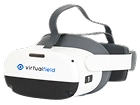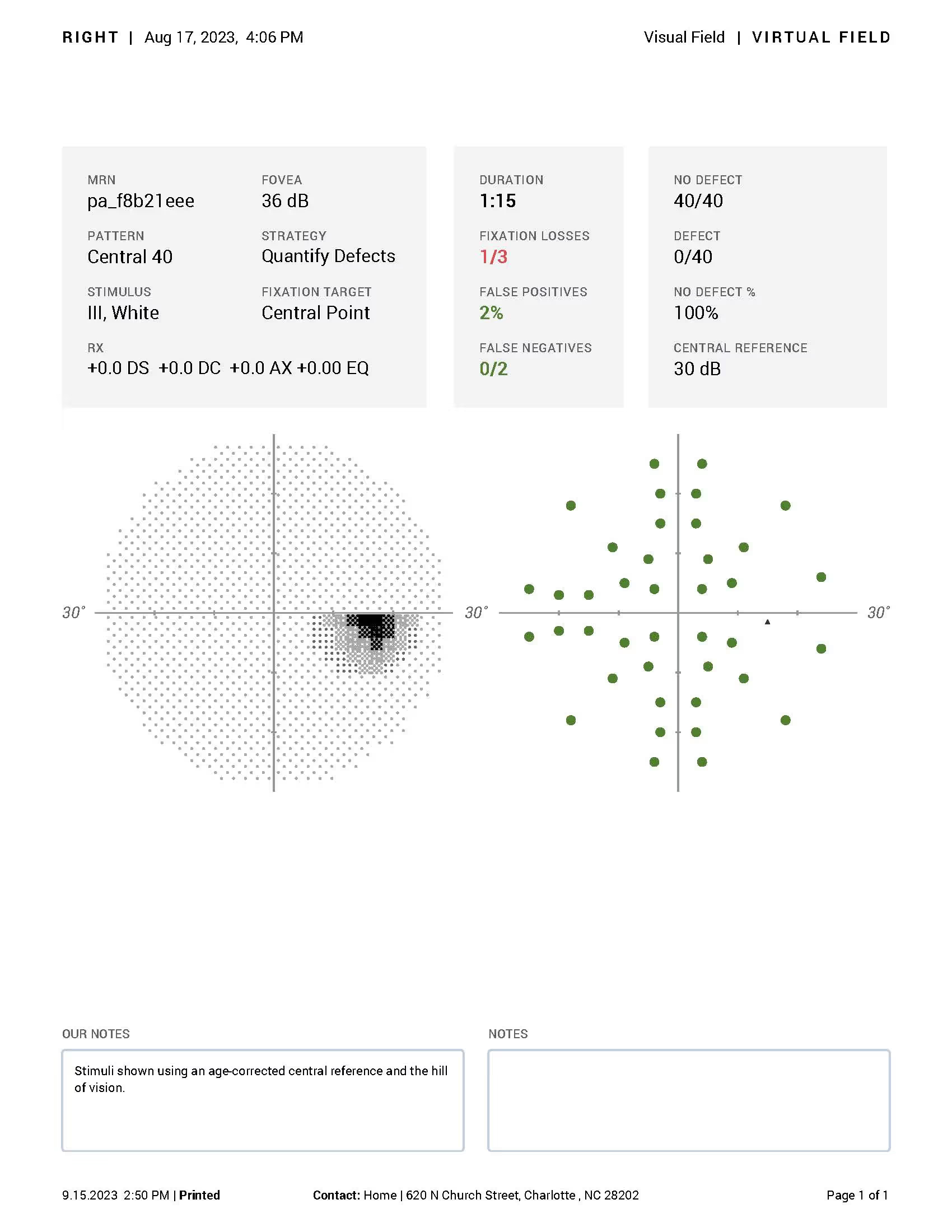When patients need medical clearance for work, driver’s licensing, or are at high risk for vision loss, the C-40 visual field screening may offer the ideal mix of speed, documentation, and clinical accuracy. This fast glaucoma screening tool uses suprathreshold stimuli and fewer points than threshold exams — making it an efficient choice in busy clinics, occupational evaluations, and primary care settings with limited time or space. The Virtual Field C-40 test improves the patient experience by delivering this screening with a portable visual field screener that’s quick, comfortable, and EHR-integrated.
The C-40 is most often used to identify considerable vision loss among patients at high risk of moderate to severe glaucoma or optic neuropathy. It's also perfect for follow-up assessments for patients with ongoing conditions that impact their vision. The C-40 is already fast and convenient, and when you conduct these exams using Virtual Field, it fits seamlessly into your patient exam workflows.
C-40 Visual Field Screening Overview
The C-40 visual field test is an efficient way to check for major vision loss in the central field, so it’s often used for occupational screenings. It measures 40 points across the central 30 degrees to reveal deficiencies that may point to glaucoma, optic nerve damage, or neurological conditions. Other visual field exams offer more insight into peripheral vision, and others have higher levels of sensitivity. However, the C-40 is reliable for an initial screening or quick follow-up assessment. From there, targeted testing can provide more conclusive results.
Because the C-40 focuses on moderate to severe vision loss, it might not catch early symptoms, but it can flag potential problems that need further testing. Traditionally, this test was done with a tabletop perimetry device that required patients to sit in a darkened room for about five minutes per eye. Today, Virtual Field makes it even faster. For patients who physically can’t or resist using a tabletop perimeter, virtual reality visual field testing offers an accessible, comfortable option you can conduct anywhere in your practice.
Virtual Field’s portable visual field screener brings this time-tested exam into the digital age — ideal for practices seeking a visual field device for primary care use.
Academic references and clinical validation
The C-40 is often cited as a reference standard or benchmark when exploring the feasibility and accuracy of techniques like SVOP.

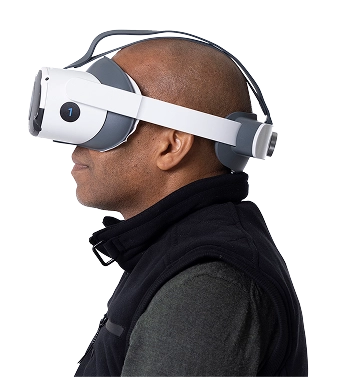
30 days free.
No strings attached.
We are confident you’ll love Virtual Field just like the 2,000 doctors who have already made the switch.
The Virtual Field C-40 Test at a Glance
For new patients, those with known defects, and those needing basic clearance for occupational screenings, the C-40 is ideal for identifying more apparent issues in the central field of vision. It’s fast, low-cost, and will identify the most pressing issues affecting a patient’s vision. The exam is efficient and convenient when added to routine screenings for moderate to severe vision loss, but it lacks sensitivity for subtler defects and peripheral vision loss.
The C-40 is often associated with detecting glaucoma, but can also monitor optic neuropathy, macular degeneration, and post-stroke visual impairments. If the C-40 picks up on visual field deficiencies, you can administer more comprehensive tests for more details.
Because of its speed and simplicity, the Virtual Field C-40 test is an excellent addition to routine exams in optometry, ophthalmology, and primary care practices needing a visual field screening solution.
Pros and Cons of the C-40 Visual Field Screening
The pros and cons that follow can help guide you toward the ideal scenarios to incorporate this suprathreshold test into your patients' diagnostic assessments.
Ideal for fast glaucoma screening in patients with known or suspected central visual field defects.
This visual field test is optimal for detecting moderate to severe visual field defects, especially in conditions like glaucoma and optic nerve damage.
The C-40 is useful for following up with patients who have known visual field defects. This test can quickly document progression or improvement.
The C-40 is available on Virtual Field’s portable visual field screener, making it easy to conduct the exam anywhere in your clinic.
The C-40 has limited sensitivity, so it may miss early-stage visual field defects and lead to false negatives.
Its focus on the central visual field ignores much of the peripheral vision and is less comprehensive than other tests.
Compared to other perimetry tests, the C-40 isn’t widely referenced because it’s used more for general screenings than diagnostics.
List of Ocular Diseases Monitored and Diagnoses Identified by the C-40 Exam
Glaucoma
The C-40 can effectively detect moderate to severe vision loss in the central vision field, which points to later stages of glaucoma. This fast and efficient test will help you assess disease progression and determine if additional testing is needed.
Stroke-Related Vision Deficits
In patients who have suffered a stroke, the C-40 can be instrumental in detecting central field defects resulting from damage to the visual processing areas of the brain. Identifying severe defects in central vision can suggest brain injury, so the C-40 can inform rehabilitation.
Diabetic retinopathy
Diabetic retinopathy can lead to damage in both the central and peripheral visual fields, but advanced stages may affect central vision due to macular edema or ischemia. The C-40 can assess moderate to severe visual loss in diabetic patients who have developed significant retinal damage.

60+
Macular Degeneration is the leading cause of vision loss in Americans aged 60 and older
2.5M
Age-Related Macular Degeneration affects 2.5 million Canadians
Macular degeneration
Vision loss associated with macular degeneration often begins with subtle changes that the patients themselves may overlook, so the C-40 is not used for early-stage cases. However, for patients with known macular degeneration, it can be helpful to outline how much of the central visual field has been affected over time and inform a treatment plan.
Optic neuropathy
Damage to the optic nerve often occurs in the central vision first, and the C-40’s suprathreshold stimuli can identify moderate to severe defects at a glance.
Other Conditions
The C-40 exam can also be used to monitor or diagnose:
- Retinitis pigmentosa
- Traumatic brain injury (TBI)
- Toxins or drugs affecting vision
Example C-40 Report
30 days free.
No strings attached.
We are confident you’ll love Virtual Field just like the 2,000 doctors who have already made the switch.
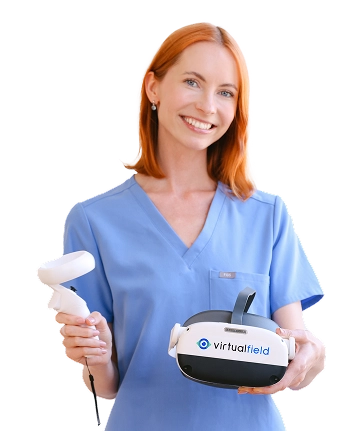
Billing and Coding for the C-40 Eye Exam
You can bill insurance for the C-40 visual field exam. This screening test falls under CPT code 92081, which is used for limited visual field exams.
The Medicare Physician Fee Schedule (MPFS) indicates reimbursement ranging from $15 to $42 per test. Your fee will vary depending on modifiers, your location, practice setting, purpose of the screening, and other factors.
When is the C-40 visual field exam required?
The C-40 is a fast, basic visual field exam that identifies moderate or severe deficiencies, so it’s well-suited for occupational screenings and driver’s licensing.
It’s often used in routine eye exams, especially for patients at risk for glaucoma, optic nerve damage, or neurological conditions. The C-40 visual field test is not as detailed as comprehensive tests, so this is typically treated as an initial screening. For patients with severe glaucoma or optic neuropathy, you may wish to offer the C-40 annually or semi-annually to monitor changes in vision.
Is the C-40 visual field test required for driver’s licenses?
No states explicitly name the C-40 as a required test for driver’s licensing, but in most states, drivers are expected to pass a visual field test. The C-40 or the Esterman are usually used for driver’s licensing because they provide quick, concise results that identify the most serious deficiencies. For patients with borderline vision, you may wish to follow up with a more comprehensive test like the 24-2.
Start Fast, Effective Visual Field Screening with Virtual Field C-40
The C-40 visual field screening was one of the first exams added to Virtual Field — and with good reason. Designed for speed, comfort, and broad application, the Virtual Field C-40 test brings perimetry into the modern age with a portable visual field screener that fits into your workflow and your exam room. Whether you’re performing a fast glaucoma screening, tracking vision loss from stroke, or offering a basic visual field test during a primary care visit, the C-40 is a reliable first line of assessment.
Save time, get a broad understanding of your patients’ vision, and monitor your highest-risk patients. Virtual Field helps you collect the most precise C-40 data possible so you can make informed decisions and give your patients a modern, comfortable experience.
Want all 23 exam guides in one place?
Download our comprehensive guide for 160+ pages of insights.
FAQs
1. What conditions is a C-40 screen best at catching?
2. How long does a bilateral C-40 take?
3. Which CPT code is correct for a C-40 Screening?
4. Do I need to dim the exam room lights?
5. What pass/fail criteria are used?
6. Can C-40 results autoload into a screening EMR template?
Ready to get started?
Schedule a demo or begin your 30-day free trial of Virtual Field to try our EOM exam in your practice.
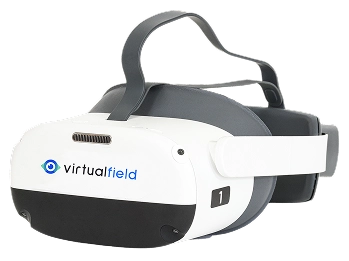
Questions? Contact sales@virtualfield.io talk to a Virtual Field expert today.

